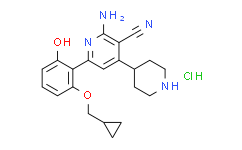| Cas No.: | 406209-26-5 |
| Chemical Name: | 2-Amino-6-(2-(cyclopropylmethoxy)-6-hydroxyphenyl)-4-(piperidin-4-yl)nicotinonitrile hydrochloride |
| Synonyms: | 2-Amino-6-(2-(cyclopropylmethoxy)-6-hydroxyphenyl)-4-(piperidin-4-yl)nicotinonitrile hydrochloride;(6E)-2-amino-6-[2-(cyclopropylmethoxy)-6-oxocyclohexa-2,4-dien-1-ylidene]-4-piperidin-4-yl-1H-pyridine-3-carbonitrile hydrochloride;2-Amino-6-[2-(cyclopropylmethoxy)-6-hydroxyphenyl]-4-(4-piperidinyl)-3-pyridinecarbonitrile hydrochloride;IKK-2 INHIBITOR VIII;Ikkb inhibitor;Bayer IKK-beta inhibitor;ACHP (Hydrochloride );ACHP Hydrochloride |
| SMILES: | Cl.N#CC1C(C2CCNCC2)=CC(=NC=1N)C3C(=CC=CC=3O)OCC4CC4 |
| Formula: | C21H24N4O2.HCl |
| M.Wt: | 400.9018 |
| Purity: | >98% |
| Sotrage: | 2 years -20°C Powder, 2 weeks 4°C in DMSO, 6 months -80°C in DMSO |
| Description: | IKK-2 inhibitor VIII( ACHP Hydrochloride) is a highly potent and selective IKK-β inhibitor with an IC50 of 8.5 nM. |
| Target: | IKK-β:8.5 nM (IC50) IKK-α:250 nM (IC50) |
| In Vivo: | ACHP (Compound 4j) is orally bioavailable in mice and rats and demonstrates significant in vivo activity in anti-inflammatory models (arachidonic acid-induced mouse ear edema model). ACHP has reasonable aqueous solubility (0.12 mg/mL in pH 7.4 isotonic buffer) and excellent Caco-2 permeability (Papp 62.3×10-7 cm/s), and demonstrates orally bioavailability in mice (BA: 16%) and rats (BA: 60%). The favourable bioavailability of ACHP in rats is likely due to its low clearance (0.33 L/h/kg). In an acute inflammation model, ACHP exhibits oral efficacy at 1 mg/kg in a dose-dependent manner[1]. |
| In Vitro: | ACHP (Compound 4j) exhibits potent IKK-β inhibitory (IC50: 8.5 nM) and cellular activities (IC50=40 nM, in A549 cells). ACHP moderately inhibits IKK-α with an IC50 of 250 nM but exhibits good selectivity towards other kinases, such as IKK3, Syk and MKK4 (IC50>20,000 nM). Moreover, ACHP demonstrates quite potent activity in various cellular assays. ACHP inhibits NF-κB-dependent reporter gene activation in TNFα-activated HEK293 cells and PMA/calcium ionophore-activated Jurkat T cells. ACHP fails to inhibit PMA-induced AP-1 activation in MRC-5 cells and PMA/calcium ionophore induced NF-κB dependent reporter gene transcription in Jurkat cells even at concentrations exceeding 10 μM. ACHP selectively interferes with the NF-κB signaling cascade by inhibition of IKK-β in living cells[1]. ACHP inhibits the growth of these cells in a dose-dependent manner. Tax-active cell lines are more susceptible to ACHP than Tax-inactive cell lines and Jurkat (IC50 values in Tax-active cell lines, Tax-inactive cell lines or Jurkat are 3.1±1.3 μM, 10.7±1.7 μM and 23.6 μM, respectively), suggesting that the growth of Tax-active cells depends on NF-κB more than Tax-inactive cells[2]. |
| Cell Assay: | HTLV-1-infected T-cell lines, ATL-35T, 81-66/45, MJ, and MT-2 cells, human ATL cell lines established from ATL patients, ATL-102, ED-40515(−) and TL-Om1 cells, and a HTLV-1-negative T-cell leukemia cell line Jurkat are used in this study. Approximately 1.5×104 cells are cultured in 96-well plate in triplicates at 37°C. Growth inhibitory effect of ACHP (0.01, 0.1, 1, 5, 10, 50 and 100 μM) is determined using MTT assay. Optical densities (OD) at 570 and 630 nm are measured with multiplate reader. Cell viability (%) is calculated[2]. |
| Animal Administration: | Mice[1] In vivo arachidonic acid-induced ear edema in mice: ear edema is induced by topical application of arachidonic acid (500 μg/ear). ACHP (0.3, 1 and 3 mg/kg, p.o.), Dexamethasone and vehicle (10% cremophor in saline) are given po 60 min before the arachidonic acid application. Ear thickness is measured at 0, 1, 3 and 6 h after the arachidonic acid application. |
| References: | [1]. Murata T, et al. Synthesis and structure-activity relationships of novel IKK-beta inhibitors. Part 3: Orally active anti-inflammatory agents. Bioorg Med Chem Lett. 2004 Aug 2;14(15):4019-22. [2]. Sanda T, et al. Induction of cell death in adult T-cell leukemia cells by a novel IkappaB kinase inhibitor. Leukemia. 2006 Apr;20(4):590-8 |

 To enhance service speed and avoid tariff delays, we've opened a US warehouse. All US orders ship directly from our US facility.
To enhance service speed and avoid tariff delays, we've opened a US warehouse. All US orders ship directly from our US facility.




















